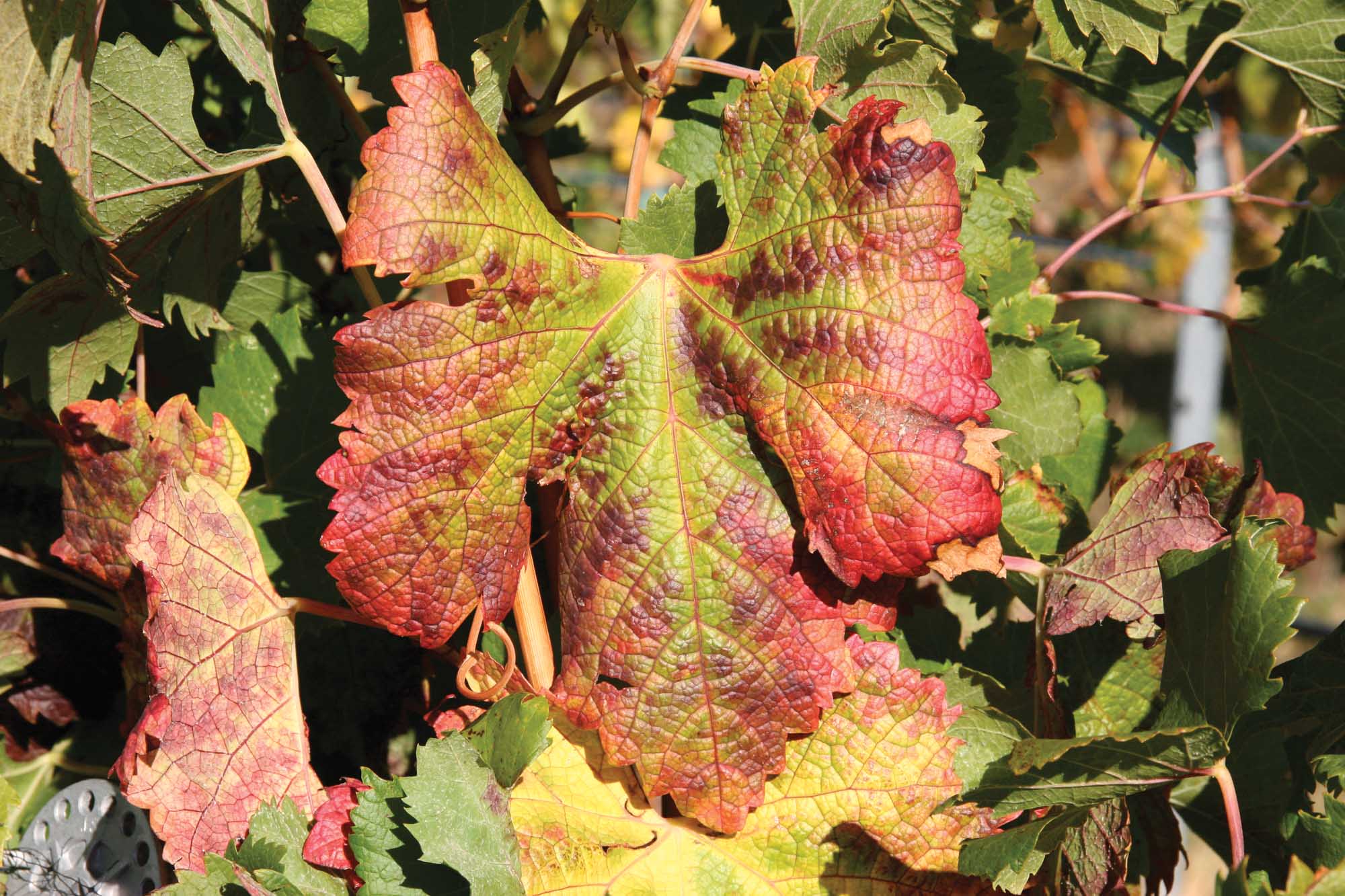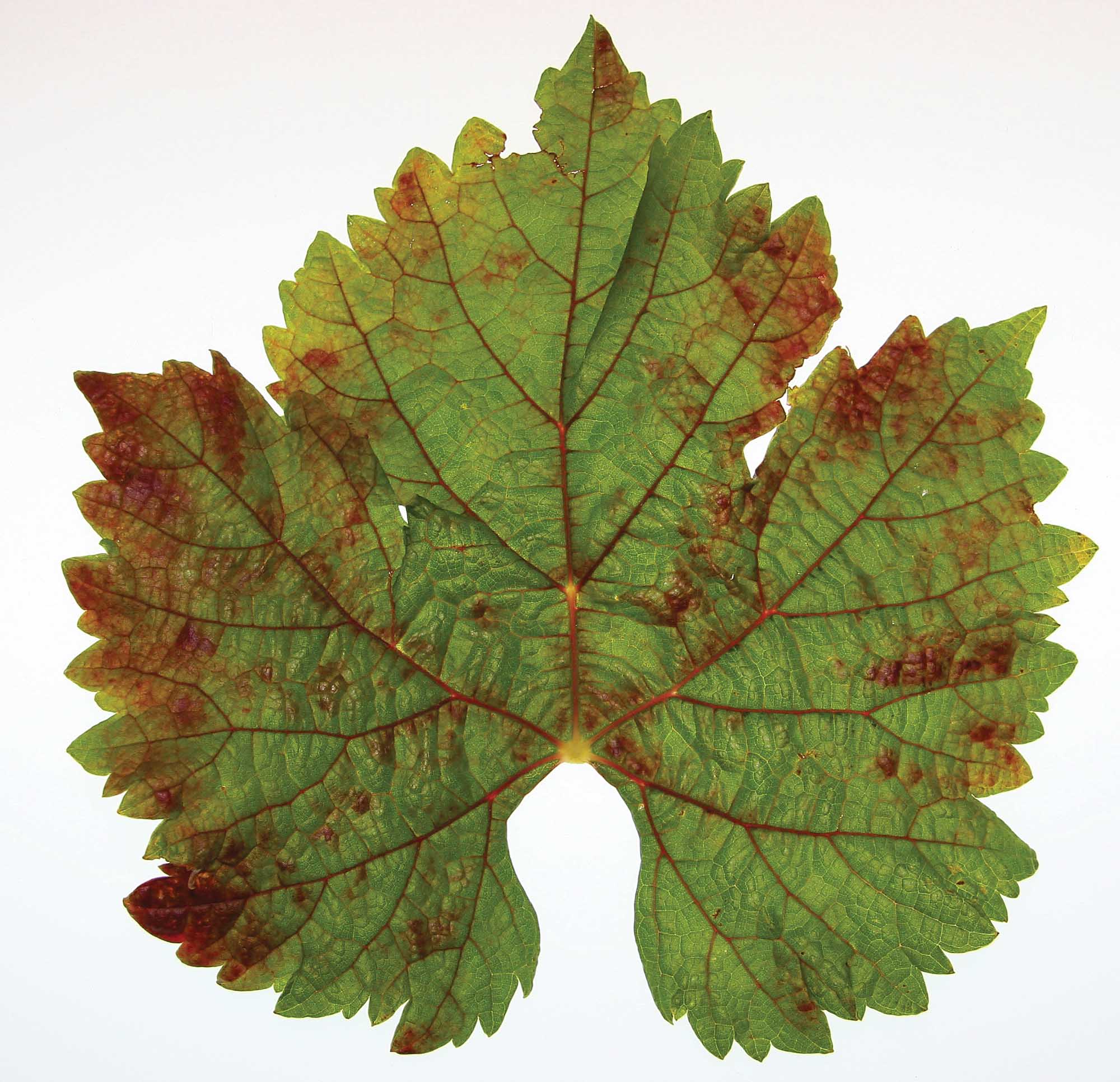
A leaf from Merlot grapevine showing red veins and red blotches on margins and interveinal regions – typical symptoms of red blotch disease. (Courtesy Washington State University)
A team of California scientists working on red blotch virus in grape vineyards suspects that a vector is involved in spreading the virus, but one has yet to be identified.
Grapevine red blotch associated virus is a relatively new disease in terms of awareness within the U.S. grape industry, but it has likely been here for decades—growers just didn’t know it because symptoms are similar to the widespread grapevine leafroll associated virus.
Since its formal designation as a virus in 2012 after DNA sequencing, scientists have been in a catch-up learning mode. Researchers across the United States have collaborated on identifying and characterizing the virus.
Red blotch disease was first recognized in 2008 in a Napa Valley vineyard by Jim Wolpert, University of California Extension viticulturist, and Mike Anderson, researcher and manager of UC Davis’ Oakville Experiment Station, according to a UC Davis news release.
The virus has been identified in young and mature vineyards in at least ten states, including Washington. A virus almost identical to red blotch was also found in Canada.
Recent tests performed on dead vine leaves in UC Davis’ Plant Herbarium show that the virus has been present in northern California’s wine grape region since the 1940s, according to news reports.
Symptoms of the two viruses are similar in that they both cause reddening of the leaves in red grape varietals. But a closer look at the leaves show distinct differences. Leaves infected with red blotch show a red blotchy pattern, leaf margins are flat, and veins are pink or red.

A Merlot grapevine shows redleaf symptoms on mature leaves in the lower portions of the canopy. Symptoms are easily confused with grapevine leafroll disease. (Courtesy Washington State University)
Leafroll infected leaves are red, but the leaf margins roll downward, and veins are green. In white varietals for both diseases, infected leaves do not turn red but may develop a yellow chlorotic hue. The leaf margin of leafroll-infected vines will roll downward, but not those with red blotch.
Growers and winemakers are concerned because the virus can significantly affect fruit and wine quality. Reduced sugar levels (up to 6° Brix) have been reported, as well as elevated titratable acidity, reduced pH, and altered tannins and phenolics.
Dr. Brian Bahder, postdoctorate researcher at UC Davis, has been working on the virus since September 2013. Bahder received his doctorate in entomology in 2013 from Washington State University, where he studied grape mealybug and its impact on leafroll disease.
He updated Washington grape growers with some of the latest red blotch research during the annual meeting of the Washington State Grape Society.
Looking for vectors

Brian Bahder
Bahder’s research at UC Davis has focused on virus spread and potential vectors. The research team includes Dr. Mysore Sudarshana, U.S. Department of Agriculture research plant pathologist, and Dr. Frank Zalom, UC Davis entomologist.
Red blotch virus is in the Geminiviridae virus family, said Bahder. “That’s important to know because viruses in that family are often transmitted by whiteflies, leafhoppers, and treehoppers.”
Although Washington State University’s Dr. Naidu Rayapati found that under controlled greenhouse conditions, Virginia creeper leafhopper could transmit red blotch virus, Bahder has not found such evidence in California.
Bahder is also looking for alternate host plants for the virus. Further testing is needed on Himalayan blackberry bushes. Initially, he found positive samples for red blotch—though at low levels—in some leaves of blackberry bushes located near an infected vineyard. But when he returned to the blackberry sites in winter during dormancy, the plants tested negative for virus.
“It could be that the plants lost infection over time,” he said. “Or the infection could be from environmental contamination, such as fecal matter left by leafhoppers.”
Bahder and the research team have been studying how the virus moves within a vineyard. They are tracking its spread in a Cabernet Sauvignon block planted in 2001 at UC Davis’ Oakville Station. Since red blotch was first identified in the block in 2011, extensive testing has been under way.
Testing of all vines in the block was completed last year. Researchers used a new diagnostic tool for red blotch disease called qPCR (quantitative polymerase chain reaction) to analyze the samples.
Evidence shows that it can be transmitted by grafting. Preliminary analysis shows there is evidence for spread in the vineyard, but more concrete results are needed to confirm the rate of spread.
It also appears there may be two genotypes or variants of red blotch. Close examination of Bahder’s vineyard map that pinpoints each infected vine showed that many of the new positive finds in one particular corner of the block in 2013 were of the newly identified genotype. He also found one sample had a mix of both red blotch genotypes.
Bahder stressed that the two genotypes in California have not yet been compared to any genetic variance that may exist in Washington State.
Clean vines
Red blotch virus has been frustrating for growers who purchased certified plant material, only to end up with the virus in their new plantings.
When purchasing certified plant material, growers should ask which viruses have been tested for, including red blotch.
Growers must also be on constant lookout for suspicious looking leaves in their vineyards. The Washington Wine Industry Foundation received specialty crop research funding to sponsor a clean plant initiative and has held numerous workshops and field days to educate growers and workers about grapevine diseases. Additionally, the wine foundation has distributed a disease identification pocket field guide in Spanish and English.
Washington growers who think they have disease in their vineyard can contact WSU’s Dr. Naidu Rayapati at naidu.rayapti@wsu.edu. •






Leave A Comment